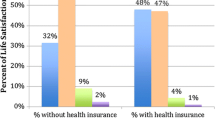Abstract
A sample of 1,042 adults was drawn from an employed population who were given the option of enrollment in any of three prepaid, HMO-type organizations, one of which was an open-panel foundation, or continued subscription in a conventional Blue Cross/Blue Shield plan. The subjects in the sample were interviewed to examine three hypothesized relationships: (1) Enrollees in any HMO will exhibit higher levels of health concern than members of other health plans. (2) Users of preventive services will exhibit a higher level of health concern than nonusers. (3) Expressed health concern is a predictor of the rate of preventive use. Data were analyzed by bivariate and multivariate techniques. Support was found for each hypothesis. We found that, although the level of perceived health status did not vary across enrollees in the various plans, those who chose a closed-panel plan reported the highest level of health concern. Health concern was positively related to the use of preventive services, and the mean number of visits as well as the percentage of individuals who use them were the largest for the members of the closed-panel plans. We also found that health concern was a predictor of preventive use. Regression analysis was used to explore various relationships between health status, health concern, plan membership, and the use of preventive services. The hypothesis of adverse self-selection is questioned. The generalizability of the findings is limited to employed, essentially middle-income groups.
Similar content being viewed by others
References
Saward EW, Greenlick MR: Health policy and the HMO.Milbank Mem Fund Q 50147–176, 1972.
Kasl SV, Cobb S: Health behavior, illness behavior and sick role behavior.Arch Environ Health 12246–266, 1966.
Bice TW: Medical care for the disadvantaged: Report on a survey of use of medical services in the Baltimore standard metropolitan statistical area 1968–69. Final report of research conducted under contract number HSM 110 69 203 from the National Center for Health Services Research and Development, 1971.
Dodge WF, West EF, Holloway JG, et al: Patterns of maternal desires for child health care.Am J Public Health 601421–1429, 1970.
Morris N, Hatch, MH, Chipman SS: Alienation as a deterrent to well-child supervision.Am J Public Health 561874–1882, 1966.
Becker MH, Kaback MM, Rosenstock IM, et al: Some influences on public participation in a genetic screening program.J Community Health 13–14, 1975.
Fink R, Shapiro S, Lewison J: the reluctant participant in a breast cancer screening program.Public Health Rep 83479–490, 1968.
Slesinger DP, Tessler RC, Mechanic D: The effects of social characteristics on the utilization of preventive medical services in contrasting health care programs.Med Care 14392–404, 1976.
Andersen R:A Behavioral Model of Families' Use of Health Services. Research Series No 25, Center for Health Administration Studies. Chicago, University of Chicago Press, 1968.
Battistella RM: Factors associated with delay in the initiation of physicians' care among late adulthood persons.Am J Public Health 611348–1361, 1971.
Battistella RM: Limitations in the use of the concept of psychological readiness to initiate health care.Med Care 6308–319, 1968.
Anderson TW:An Introduction to Multivariate Statistical Analysis. New York, John Wiley & Sons, 1958.
Morrison DF:Multivariate Statistical Methods. New York, McGraw-Hill Book Co, 1967.
Marriott FHC:The Interpretation of Multiple Observations. New York, Academic Press, 1974.
Berki SE, Ashcraft ML, Penchansky R, et al: Enrollment choice in a multi-HMO setting: The roles of health risk, financial vulnerability and access to care.Med Care 1595–114, 1977.
Heatherington RW, Hopkins CE, Roemer MI:Health Insurance Plans: Promise and Performance. New York, John Wiley & Sons, 1975.
Van de Geer JP:Introduction to Multivariate Analysis for the Social Sciences. San Francisco, W. H. Freeman and Co, 1971.
Kmenta J:Elements of Econometrics. New York, Macmillan Publishing Co, 1971.
Dhrymes PJ:Econometrics, Statistical Foundations and Applications. New York, Harper & Row, 1970.
Berki SE, Kobashigawa B: Socioeconomic and need determinants of ambulatory care use: Path analysis of the 1970 Health Interview Survey data.Med Care 14405–421, 1976.
Additional information
The authors are, respectively, Professor, Research Associate, Professor, and Research Associate in the Department of Medical Care Organization, School of Public Health, The University of Michigan, Ann Arbor, Michigan 48109. This paper was presented in part at the 104th Annual Meeting of the American Public Health Association, October 17–21, 1976. The work herein reported was supported by grant OEO 51517, Evaluation of the Community Health Networks, now administered by the National Center for Health Services Research. The opinions expressed are those of the authors and should not be construed as representing the opinions of any agency of the United States Government.
Rights and permissions
About this article
Cite this article
Berki, S.E., Ashcraft, M., Penchansky, R. et al. Health concern, HMO enrollment, and preventive care use. J Community Health 3, 3–31 (1977). https://doi.org/10.1007/BF01319140
Issue Date:
DOI: https://doi.org/10.1007/BF01319140




